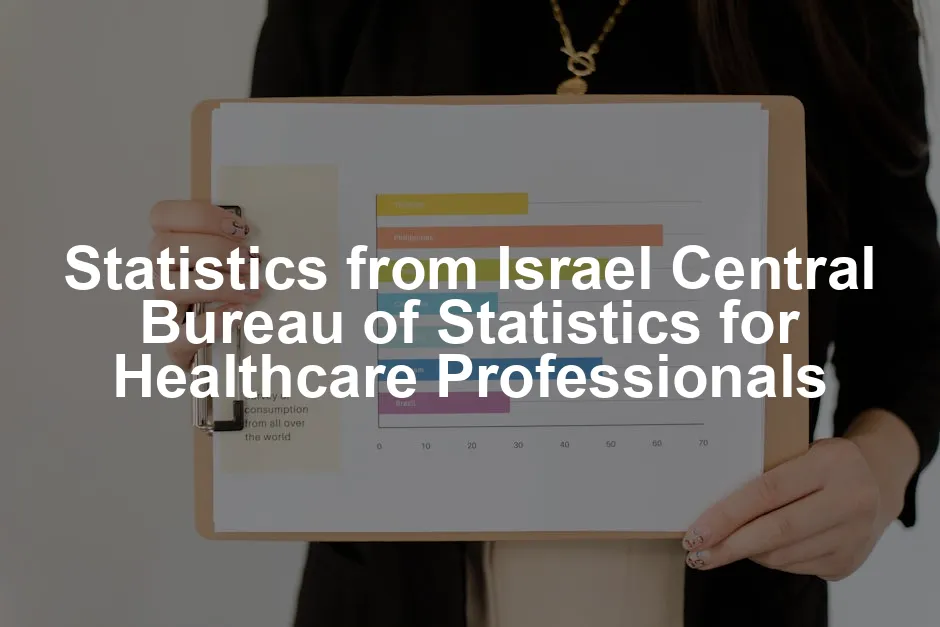Introduction
In the bustling arena of healthcare, facts and figures are not just numbers; they are game changers. The Central Bureau of Statistics (CBS) in Israel stands as a beacon of reliable data, illuminating the path for healthcare professionals. This treasure trove of statistics can significantly enhance decision-making processes for physicians, nurses, and health administrators alike.
Understanding health metrics is critical. They serve as a compass, guiding professionals through the complexities of patient needs, resource allocation, and public health strategies. With the CBS’s insights, healthcare providers can ensure that they are not just treating patients but also anticipating healthcare demands and trends.
For instance, the CBS offers robust data on population demographics, health expenditures, and prevalent health conditions. These statistics reveal not only who the patients are but also what challenges they might face. This information is invaluable for tailoring treatment plans and preventive strategies that resonate with individual and community needs.
Moreover, the CBS provides forecasts that help professionals prepare for the future. With projections on population growth and aging trends, healthcare providers can strategize to meet the evolving demands of their patients. For example, the increasing elderly population in Israel signals a rising need for geriatric care and chronic disease management.
The metrics related to health expenditures also reveal significant insights. With healthcare spending representing a substantial percentage of Israel’s GDP, understanding these statistics can help professionals advocate for necessary reforms and resource allocations. This knowledge fosters better planning, ensuring that healthcare systems remain efficient and responsive.
Additionally, the CBS highlights trends in health conditions, such as smoking rates and obesity statistics. These factors directly impact patient care and public health initiatives. Armed with this data, healthcare professionals can implement targeted interventions that address these pressing issues. Learn more about obesity statistics in Australia.
Understanding the trends in health conditions such as obesity is crucial for healthcare professionals. Explore the obesity statistics in Australia for further insights.
In summary, the statistics provided by Israel’s Central Bureau of Statistics are not mere numbers. They embody the foundation upon which effective healthcare is built. By engaging with this data, healthcare professionals can enhance their practices, improve patient outcomes, and contribute to a more robust healthcare system. Let’s dive into the specific metrics that can make a difference in your healthcare practice!

Summary
This article will provide an in-depth overview of key healthcare statistics from Israel’s Central Bureau of Statistics, specifically tailored for healthcare professionals. We will cover various aspects, including population demographics, health expenditures, life expectancy, prevalent health conditions, and healthcare service utilization. You’ll discover the latest figures on the Israeli population, including growth trends and age distributions, as well as insights into government spending on health and its implications for the healthcare system. We will also touch on emerging health trends such as smoking rates, obesity, and chronic diseases. By the end of this blog post, you’ll not only have a comprehensive understanding of the current state of healthcare in Israel but also how these statistics can inform your practice and improve patient care.
For a thorough understanding of summary statistics, you can refer to the Comprehensive Guide to Summary Statistics Tables.
Key Sections
1. Overview of Israel’s Healthcare System
1.1 Structure of the Healthcare System
Israel boasts a universal healthcare system. It ensures every citizen has access to essential medical services. The backbone of this system is the Health Management Organizations (HMOs). These organizations, also known as Kupot Holim, play a pivotal role. They provide various health services, including hospitalization and outpatient care.
In Israel, residents can choose from four main HMOs: Clalit, Maccabi, Leumit, and Meuhedet. Each offers a unique array of services, but all adhere to government regulations. This ensures a consistent level of care across the board.
Public healthcare in Israel is primarily funded through taxation. Citizens pay a health tax, typically around 5% of their income. This tax is pooled to finance the healthcare system. However, private healthcare options are also available. Many Israelis opt for supplementary private insurance. This allows quicker access to specialists and elective procedures.
The coexistence of public and private healthcare creates a dynamic system. While public services are generally robust, the private sector can alleviate pressure during peak times. This duality ensures that patients receive timely care, regardless of the healthcare setting they choose.

1.2 Key Statistics and Trends
Current healthcare expenditure in Israel stands at approximately 7.2% of the GDP. This figure reflects a steady investment in health services over the past few years. To put this into perspective, the OECD average is around 9.3%.
In the latest budget report, the total healthcare budget is about NIS 136.3 billion. This amount covers various aspects of healthcare, including hospital funding, outpatient services, and preventive care. A significant portion of this budget is allocated to hospital services, reflecting the need for comprehensive inpatient care.
Moreover, the allocation of resources is crucial. Approximately 30% of the healthcare budget is directed towards community health services. This investment aims to bolster primary care and preventive services. Speaking of preventive measures, if you’re looking to adopt a healthier lifestyle, check out The Wellness Way: How to Achieve Your Health Goals. It’s an excellent guide for anyone looking to enhance their health journey!
Trends show a growing focus on digital health technologies. This shift is driven by innovations in telemedicine and electronic health records. The government encourages this transformation, aiming to enhance the efficiency of healthcare delivery.
As Israel’s population continues to grow, trends indicate an increasing demand for healthcare services. The aging population necessitates a more robust healthcare infrastructure. This demographic shift highlights the importance of continuous investment in both public and private sectors.

2. Population Demographics and Health Metrics
2.1 Population Statistics
Israel’s population is currently estimated at approximately 9.915 million. This figure encompasses a diverse demographic landscape. About 7.632 million are Jews, representing 77% of the population. Meanwhile, roughly 2.067 million are Arabs, making up 20.8%.
The population growth rate stands at 1.6%. This reflects a slight decrease from the previous year’s 2.2%. The government closely monitors these trends, as they directly impact healthcare needs and resource allocation.
Breaking down the population further reveals intriguing insights. Approximately 43.5% of the population identifies as secular. Non-religious traditionalists account for 18.9%, while religious traditionalists make up 13%. Religious individuals and ultra-Orthodox communities represent 12.5% and 11.3%, respectively.
As the population grows, projections indicate that Israel’s demographics will continue evolving. The increasing number of elderly individuals will require more specialized healthcare services. This trend underscores the importance of adapting healthcare strategies to meet future demands effectively.

2.2 Life Expectancy and Mortality Rates
Life expectancy in Israel is remarkable. As of 2023, average life expectancy stands at 81 years for men and 85.5 years for women. This places Israel among the top countries globally for longevity. So, what’s the secret? A combination of advanced healthcare, healthy diets, and a focus on preventive care is at play. If you’re interested in understanding how to tackle chronic unhappiness, consider reading The Mindful Way Through Depression: Freeing Yourself from Chronic Unhappiness. It’s a fantastic resource for anyone looking to enhance their mental well-being!
However, like any good story, there are challenges. The leading causes of death in Israel are primarily chronic diseases. Cancer accounts for over 22% of all fatalities, with heart disease and strokes following closely behind. This highlights the need for ongoing education and preventative measures in these areas.
When it comes to infant mortality, the numbers are equally telling. The infant mortality rate is about 2.6 deaths per 1,000 live births, showing significant improvements over the years. This statistic reflects the quality of maternal and newborn care in the country.
Speaking of maternal health, maternal mortality rates also paint a positive picture. Israel boasts one of the lowest maternal mortality rates globally, thanks to skilled healthcare professionals and accessible prenatal care.
These statistics from the Central Bureau of Statistics are vital for healthcare professionals. They offer insights into the effectiveness of current health policies and highlight areas needing attention. Understanding these figures allows practitioners to tailor their approaches to meet the unique needs of their patients better.

3. Health Challenges in Israel
3.1 Prevalent Health Conditions
Chronic diseases are on the rise in Israel, with diabetes, heart disease, and cancer leading the charge. Approximately 10.5% of the adult population is living with diabetes, a statistic that raises eyebrows. Heart disease follows closely, affecting nearly 18% of adults.
When it comes to cancer, the numbers are staggering. The World Health Organization reports that nearly 40% of Israelis will be diagnosed with some form of cancer in their lifetime. Alarmingly, these statistics shine a light on the increasing prevalence of lifestyle-related diseases that call for immediate action. To combat such lifestyle-related conditions, consider incorporating healthy cooking into your routine with The Cancer-Fighting Kitchen: Nourishing, Big-Flavor Recipes for Cancer Treatment and Recovery. It’s a great resource filled with delicious and healthy recipes!
Mental health issues are also on the rise. A recent survey indicated that around 25% of the population experiences some form of mental health condition. Anxiety and depression are among the most reported issues. This growing concern emphasizes the necessity for mental health services in the healthcare system.

3.2 Lifestyle Factors
Lifestyle choices significantly impact public health in Israel. Smoking rates, for instance, remain stubbornly high. About 18.2% of adults smoke daily, and an additional 22.2% are occasional smokers. This statistic isn’t just a number; it represents a major public health challenge.
Obesity is another growing concern. Almost half of the adult population is categorized as overweight, obese, or severely obese. This trend correlates with the rise of lifestyle-related diseases in the country. If you’re looking to shed some pounds, consider investing in a Food Scale with Nutritional Calculator. It can help you track your food intake and make healthier choices!
The implications for public health are profound. As lifestyle-related diseases proliferate, healthcare providers must pivot to focus on prevention and education. Programs that promote healthy eating, physical activity, and smoking cessation are essential in combating these trends.
In summary, the health challenges in Israel reflect broader global issues. With the right strategies in place, healthcare professionals can address these concerns effectively, paving the way for a healthier future for all.

4. Healthcare Utilization and Access
4.1 Access to Healthcare Services
In Israel, the healthcare system is robust, boasting a high number of healthcare professionals. Currently, there are approximately 4.3 physicians per 1,000 people, which is higher than the OECD average. This translates into about 38,000 practicing physicians across the country. Nurses are also in significant supply, with around 80,000 registered nurses providing essential care.
The distribution of these healthcare professionals is crucial. Most physicians practice in urban areas, while rural regions face a shortage. This uneven distribution leads to disparities in healthcare access. Residents in cities enjoy better access to specialists and advanced medical facilities compared to those in the countryside.
When it comes to healthcare service utilization, the statistics reveal interesting trends. Emergency services are heavily utilized, with a staggering 1.5 million emergency department visits annually. This number showcases the importance of quick access to urgent care. However, elective surgeries remain underutilized. Only about 30% of patients who require elective procedures choose to undergo them, often due to long waiting times or lack of awareness regarding available options.
These numbers raise questions about patients’ understanding of their healthcare rights. Many may not realize they can seek services outside their local area or that waiting lists can be navigated. With better education and outreach, utilization rates for elective services could improve, leading to better overall health outcomes.

4.2 Patient Satisfaction and Outcomes
Patient satisfaction is a critical measure of healthcare quality. According to recent surveys, approximately 87% of Israelis report satisfaction with their healthcare services. This high satisfaction rate can be attributed to the universal healthcare system, which ensures that all citizens have access to necessary medical care.
However, satisfaction levels vary by service type. For instance, outpatient services receive higher satisfaction ratings compared to inpatient care. Patients often cite long wait times and perceived rushed consultations as areas needing improvement.
In terms of healthcare outcomes, Israel excels in several key metrics. The average life expectancy is impressive, standing at 81 years for men and 85.5 years for women. Moreover, the infant mortality rate is notably low, at 2.6 deaths per 1,000 live births. These figures illustrate the effectiveness of Israel’s healthcare system in delivering positive health outcomes.
Moreover, cancer remains the leading cause of death, accounting for over 22% of fatalities. This statistic emphasizes the ongoing need for advancements in treatment and early detection methods. The healthcare system is increasingly focusing on preventive measures, with national campaigns aimed at reducing smoking and promoting healthier lifestyles.
The effectiveness of treatments is also noteworthy. Studies indicate that about 90% of patients with chronic conditions report effective management of their illnesses. This success is due to a combination of accessible healthcare services and ongoing patient education initiatives.
The interplay of access to healthcare professionals, the utilization of services, and patient satisfaction creates a complex picture. By addressing the gaps in service access and focusing on patient education, Israel can continue to improve its healthcare outcomes and maintain high levels of satisfaction among its citizens.

5. Future Trends and Projections
5.1 Innovations in Healthcare
As we look toward the future, the healthcare landscape in Israel is ripe for innovation. The rise of technology is transforming patient care. Digital health solutions, such as telemedicine and electronic health records, are becoming increasingly mainstream. These innovations enhance accessibility and streamline the healthcare experience for both providers and patients.
Moreover, Israel is a global leader in health tech startups. In 2021 alone, the sector raised an impressive $14.7 billion in funding. This influx of capital is fostering advancements in medical devices, pharmaceuticals, and health services. The focus on integrating technology into healthcare delivery can significantly improve patient outcomes.
Future projections indicate that the healthcare workforce will need to adapt. With the population aging, there is an increasing demand for geriatric care. By 2040, it is estimated that the percentage of the population over 65 will reach 15%. This demographic shift will require a strategic approach to healthcare service delivery, including specialized training for healthcare professionals in geriatric medicine.
Additionally, the government plans to build eight new hospitals and 19 geriatric centers by 2048. This expansion is vital to meet the growing healthcare demands. These facilities will not only alleviate current pressures on the healthcare system but also ensure that future generations receive the care they need. Speaking of future planning, ensure you’re prepared with a reliable First Aid Kit for Home and Travel. It’s essential for any household!
As Israel continues to embrace innovations in healthcare, the focus will remain on improving accessibility, enhancing patient outcomes, and fostering a health-conscious society. By leveraging technology and addressing demographic shifts, Israel’s healthcare system is poised for a promising future.

5.2 Policy Recommendations
As healthcare professionals navigate the evolving landscape of patient care, the statistics from Israel’s Central Bureau of Statistics (CBS) reveal critical insights. These insights can inform policy changes that address emerging challenges in healthcare.
The data indicates a growing elderly population, which is projected to reach 15% by 2040. This demographic shift necessitates a stronger emphasis on geriatric care and chronic disease management. Healthcare policies should prioritize resources for training and equipping professionals to meet the unique needs of aging patients.
Furthermore, the rise in chronic diseases such as diabetes and heart disease highlights the need for preventive care initiatives. Policies should focus on expanding community health programs that promote healthy lifestyles and regular screenings. By investing in prevention, we can reduce the burden of chronic illnesses and improve overall public health.
Addressing mental health is another pressing challenge. With about 25% of the population experiencing mental health issues, there is an urgent need for policies that enhance access to mental health services. This includes integrating mental health care into primary care settings, ensuring that professionals are trained to recognize and address these issues effectively.
Another crucial recommendation involves leveraging technological advancements. The data shows that Israel is a leader in health tech innovations. Policies should encourage the adoption of telemedicine and digital health records, making healthcare more accessible and efficient. This approach can bridge gaps in care, especially for individuals in remote areas.
Additionally, the CBS data reveals disparities in healthcare access between urban and rural populations. Policies must aim to equalize access to healthcare services, ensuring that rural communities have sufficient healthcare professionals and facilities. Incentives could be offered to practitioners who choose to work in underserved areas, promoting a more equitable healthcare system.
Lastly, continuous education and training for healthcare professionals are essential. As medical advancements occur, policies should support ongoing education to keep professionals updated on the latest practices and technologies. This commitment to lifelong learning will ensure that healthcare providers can deliver the highest quality of care.
In conclusion, the statistics from the CBS serve as a foundation for informed policy recommendations. By addressing the specific challenges highlighted in the data, healthcare professionals can work collaboratively with policymakers to enhance the accessibility, efficiency, and effectiveness of Israel’s healthcare system.

Conclusion
In conclusion, the statistics from Israel’s Central Bureau of Statistics provide a comprehensive overview of the healthcare landscape, highlighting critical trends and challenges that healthcare professionals must navigate. Understanding these statistics can equip you with the knowledge needed to enhance patient care, advocate for necessary reforms, and contribute to the overall improvement of the healthcare system. By leveraging data, we can work towards a healthier future for all Israelis.
The current population of Israel is approximately 9.915 million, with a significant portion being elderly. This demographic shift calls for an urgent focus on geriatric care, emphasizing the need for specialized training for healthcare providers. With life expectancy reaching 81 years for men and 85.5 years for women, the demand for chronic disease management is on the rise.
Furthermore, chronic diseases such as diabetes and heart disease are prevalent, affecting about 10.5% and 18% of adults, respectively. This necessitates an increased emphasis on preventive care and health education initiatives. By fostering a culture of health awareness, healthcare professionals can mitigate the risk of these conditions in their patients.
Mental health also poses a significant challenge, with around 25% of the population experiencing various mental health issues. Integrating mental health services into primary care can help professionals address these concerns effectively. It’s vital to create an environment where individuals feel comfortable seeking help and where mental health resources are readily available.
The healthcare expenditure in Israel is substantial, amounting to around NIS 136.3 billion, which constitutes approximately 7.2% of the GDP. This investment is crucial for maintaining high-quality healthcare services. However, it’s essential to ensure that these funds are allocated efficiently, targeting areas that directly impact patient care.
Moreover, the data reveals disparities in access to healthcare services based on geographic location. Urban areas tend to have better access to healthcare professionals and facilities compared to rural regions. Addressing these disparities through policy changes and resource allocation is critical to ensuring that all citizens receive equitable healthcare.
Technological advancements in healthcare cannot be overlooked. Israel has a vibrant health tech sector, and policies encouraging the adoption of telemedicine and electronic health records can significantly enhance patient engagement and care delivery. Embracing these innovations will lead to more streamlined and effective healthcare services.
In summary, the statistics from the Central Bureau of Statistics are not just numbers; they represent the pulse of Israel’s healthcare system. By understanding these statistics, healthcare professionals can better navigate the complex landscape of patient care, advocate for necessary reforms, and contribute to the overall improvement of the healthcare system. Together, we can leverage data to create a healthier future for all Israelis, ensuring that every individual has access to quality healthcare.
Where can I find the latest statistics from the Central Bureau of Statistics?
You can access the latest statistics on the CBS website, which regularly publishes updated reports and data.
How can healthcare professionals use these statistics in their practice?
Healthcare professionals can utilize these statistics to identify health trends, allocate resources effectively, and tailor patient care strategies.
What are some key health indicators to watch for in Israel?
Key indicators include life expectancy, prevalence of chronic diseases, healthcare expenditure, and patient satisfaction rates.
How does Israel’s healthcare system compare globally?
Israel’s healthcare system is often noted for its efficiency and high standards, with various metrics indicating strong outcomes compared to other OECD countries.
Please let us know what you think about our content by leaving a comment down below!
Thank you for reading till here 🙂
All images from Pexels




